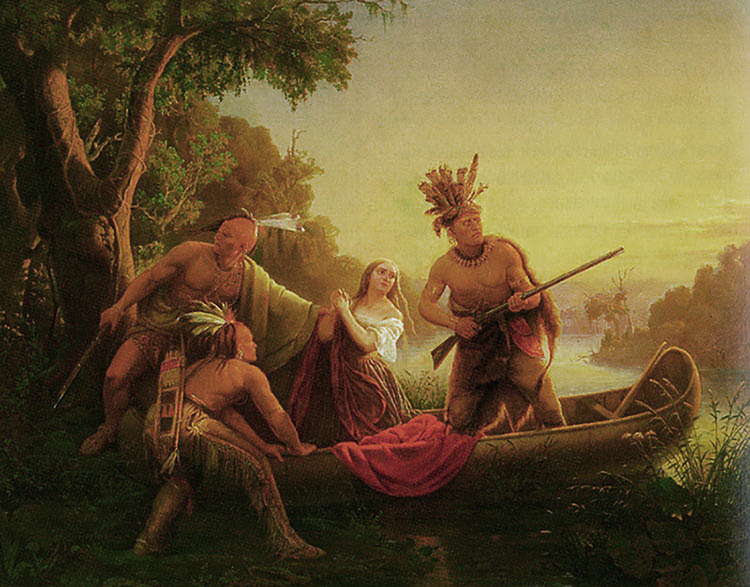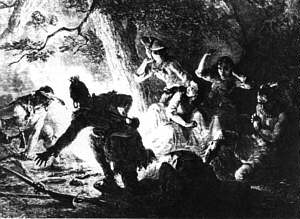Capture and rescue of Jemima Boone on:
[Wikipedia]
[Google]
[Amazon]

 The capture and rescue of Jemima Boone and the Callaway girls is a famous incident in the colonial
The capture and rescue of Jemima Boone and the Callaway girls is a famous incident in the colonial

 The capture and rescue of Jemima Boone and the Callaway girls is a famous incident in the colonial
The capture and rescue of Jemima Boone and the Callaway girls is a famous incident in the colonial history of Kentucky
The prehistory and history of Kentucky span thousands of years, and have been influenced by the state's diverse geography and central location. Based on evidence in other regions, it is likely that the human history of Kentucky began sometime b ...
. Three girls were captured by a Cherokee
The Cherokee (; chr, ᎠᏂᏴᏫᏯᎢ, translit=Aniyvwiyaʔi or Anigiduwagi, or chr, ᏣᎳᎩ, links=no, translit=Tsalagi) are one of the indigenous peoples of the Southeastern Woodlands of the United States. Prior to the 18th century, t ...
-Shawnee
The Shawnee are an Algonquian-speaking indigenous people of the Northeastern Woodlands. In the 17th century they lived in Pennsylvania, and in the 18th century they were in Pennsylvania, Ohio, Indiana and Illinois, with some bands in Kentucky a ...
raiding party on July 14, 1776 and rescued three days later by Daniel Boone
Daniel Boone (September 26, 1820) was an American pioneer and frontiersman whose exploits made him one of the first folk heroes of the United States. He became famous for his exploration and settlement of Kentucky, which was then beyond the we ...
and his party, celebrated for their success. The incident was portrayed in 19th-century literature and paintings: James Fenimore Cooper
James Fenimore Cooper (September 15, 1789 – September 14, 1851) was an American writer of the first half of the 19th century, whose historical romances depicting colonist and Indigenous characters from the 17th to the 19th centuries brought h ...
created a fictionalized version of the episode in his novel ''The Last of the Mohicans
''The Last of the Mohicans: A Narrative of 1757'' is a historical romance written by James Fenimore Cooper in 1826.
It is the second book of the '' Leatherstocking Tales'' pentalogy and the best known to contemporary audiences. '' The Pathfinde ...
'' (1826) and Charles Ferdinand Wimar painted ''The Abduction of Boone's Daughter by the Indians'' (c. 1855).
History
After the outbreak of theAmerican Revolutionary War
The American Revolutionary War (April 19, 1775 – September 3, 1783), also known as the Revolutionary War or American War of Independence, was a major war of the American Revolution. Widely considered as the war that secured the independence of t ...
in 1775, violence increased between Native Americans and settlers in Kentucky
Kentucky ( , ), officially the Commonwealth of Kentucky, is a state in the Southeastern region of the United States and one of the states of the Upper South. It borders Illinois, Indiana, and Ohio to the north; West Virginia and Virginia to ...
. American Indians, particularly Shawnee
The Shawnee are an Algonquian-speaking indigenous people of the Northeastern Woodlands. In the 17th century they lived in Pennsylvania, and in the 18th century they were in Pennsylvania, Ohio, Indiana and Illinois, with some bands in Kentucky a ...
from north of the Ohio River
The Ohio River is a long river in the United States. It is located at the boundary of the Midwestern and Southern United States, flowing southwesterly from western Pennsylvania to its mouth on the Mississippi River at the southern tip of Illino ...
, raided the Kentucky settlements, hoping to drive away the settlers, whom they regarded as trespassers. The Cherokee
The Cherokee (; chr, ᎠᏂᏴᏫᏯᎢ, translit=Aniyvwiyaʔi or Anigiduwagi, or chr, ᏣᎳᎩ, links=no, translit=Tsalagi) are one of the indigenous peoples of the Southeastern Woodlands of the United States. Prior to the 18th century, t ...
, led by Dragging Canoe
Dragging Canoe (ᏥᏳ ᎦᏅᏏᏂ, pronounced ''Tsiyu Gansini'', "he is dragging his canoe") (c. 1738 – February 29, 1792) was a Cherokee war chief who led a band of Cherokee warriors who resisted colonists and United States settlers in the ...
, frequently attacked isolated settlers and hunters, convincing many to abandon Kentucky. This was part of a 20-year Cherokee resistance to pioneer settlement. By the late spring of 1776, fewer than 200 Americans remained in Kentucky, primarily at the fortified settlements of Boonesborough Boonesborough or Boonesboro may refer to a place in the United States:
* Boonesboro, Iowa, now part of Boone, Iowa
*Boonesborough, Kentucky
*Boonesboro, Missouri
Boonesboro is a community in Howard County, Missouri, United States. It is located o ...
, Harrodsburg
Harrodsburg is a home rule-class city in Mercer County, Kentucky, United States. It is the seat of its county. The population was 9,064 at the 2020 census.
Although Harrodsburg was formally established by the House of Burgesses after Boonesbor ...
, and Logan's Station
Benjamin Logan (May 1, 1743 – December 11, 1802) was an American pioneer, soldier, and politician from Virginia, then Shelby County, Kentucky. As colonel of the Kentucky County, Virginia militia during the American Revolutionary War, he was se ...
in the southeastern part of the state.
On July 14, 1776, a raiding party caught three teenage girls from Boonesborough as they were floating in a canoe on the Kentucky River
The Kentucky River is a tributary of the Ohio River, long,U.S. Geological Survey. National Hydrography Dataset high-resolution flowline dataThe National Map , accessed June 13, 2011 in the Commonwealth (U.S. state), U.S. Commonwealth of Kentuc ...
. They were Jemima, daughter of Daniel Boone, and Elizabeth and Frances, daughters of Colonel Richard Callaway
Richard Callaway (June 14, 1717 – November 8, 1780) was an American frontiersman, military officer, politician, and hunter who was one of the first white settlers in modern-day Kentucky. Born in Essex County, Virginia, Callaway joined Daniel B ...
. The Cherokee Hanging Maw
Hanging Maw, or ''Uskwa'li-gu'ta'' in Cherokee, was the leading chief of the Overhill Cherokee from 1788 to 1794. They were located in present-day southeastern Tennessee. He became chief following the death of Old Tassel, and the abandonment of ...
led the raiders, two Cherokee and three Shawnee warriors. The girls' capture raised alarm and Boone organized a rescue party. Meanwhile, the captors hurried the girls north toward the Shawnee towns across the Ohio River. The girls attempted to mark their trail until threatened by the Indians.
The third morning, as the Indians were building a fire for breakfast, the rescuers came up. As one captor was shot, Jemima said, "That's daddy's!" (gun). He was not immediately killed. Two of the wounded Native men later died. The captors retreated, leaving the girls to be taken home by the settlers.
Jemima married Flanders Callaway, who had been one of the rescuing party. Elizabeth Callaway married Samuel Henderson, and Frances married John Holder. The episode served to put the settlers in the Kentucky wilderness on guard and prevented their straying beyond the fort. Although the rescuers had feared the girls would be raped or otherwise abused, Jemima Boone said, "The Indians were kind to us, as much so as they well could have been, or their circumstances permitted."
Representation in media
*The incident is notable for inspiring the chase scene inJames Fenimore Cooper
James Fenimore Cooper (September 15, 1789 – September 14, 1851) was an American writer of the first half of the 19th century, whose historical romances depicting colonist and Indigenous characters from the 17th to the 19th centuries brought h ...
's ''The Last of the Mohicans
''The Last of the Mohicans: A Narrative of 1757'' is a historical romance written by James Fenimore Cooper in 1826.
It is the second book of the '' Leatherstocking Tales'' pentalogy and the best known to contemporary audiences. '' The Pathfinde ...
'' (1826), in which Lieutenant-Colonel George Munro, the book's protagonist Hawkeye (Natty Bumppo
Nathaniel "Natty" Bumppo is a fictional character and the protagonist of James Fenimore Cooper's pentalogy of novels known as the '' Leatherstocking Tales''.
Fictional biography
Natty Bumppo, the child of white parents, grew up among Delaware ...
), his adopted Mohican
The Mohican ( or , alternate spelling: Mahican) are an Eastern Algonquian Native American tribe that historically spoke an Algonquian language. As part of the Eastern Algonquian family of tribes, they are related to the neighboring Lenape, who ...
older brother Chingachgook
Chingachgook is a fictional character in four of James Fenimore Cooper's five '' Leatherstocking Tales'', including his 1826 novel ''The Last of the Mohicans''. Chingachgook was a lone Mohican chief and companion of the series' hero, Natty Bumppo. ...
, Chingachgook's son Uncas
Uncas () was a ''sachem'' of the Mohegans who made the Mohegans the leading regional Indian tribe in lower Connecticut, through his alliance with the New England colonists against other Indian tribes.
Early life and family
Uncas was born n ...
, and David Gamut follow and overtake the Huron party of Magua
Magua is a fictional character and the main antagonist in the 1826 novel ''The Last of the Mohicans'' by James Fenimore Cooper. This historical novel is set at the time of the French and Indian War. A Wyandot people, Huron Native Americans in the ...
who had taken as captives the sisters Cora and Alice Munro.
*The incident was also portrayed in 19th-century historical paintings for its dramatic clash of two cultures. Charles Ferdinand Wimar painted ''The Abduction of Boone's Daughter by the Indians'' (c. 1855).
*The rescue was featured as an illustration in William A. Crafts, ''Pioneers in the Settlement of America'' (1877).William A. Crafts, ''Pioneers in the Settlement of America'', Boston, 1877
References
Further reading
*Draper, Lyman. ''The Life of Daniel Boone'', edited by Ted Franklin Belue. Mechanicsburg, PA: Stackpole Books, 1998. * * {{DEFAULTSORT:Boone, Jemima Kentucky in the American Revolution Shawnee history 18th century Cherokee history Children in war 1776 in Kentucky Captives of Native Americans Boone family (pioneers)